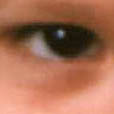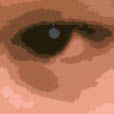| |
Yet another real-world source of blurred forms are shadows, which are
never too crisp (because the sources of light are never sizeless dots).
Therefore, blurs are commonly used for drop shadows and other pseudo-3D
effects. An artificial shadow is capable of adding an immediate and
recognizable background plane, so that the main image becomes more
prominent, closer and even (by contrast) crisper. Adding a shadow plane
is meaningful only if the graphic itself is flat and crisp-edged by
its nature, that's why the 3D uses of blurring are much more common for
text headings and geometric forms (as opposed to the two previous blur
themes, usually applied to photographic images).
Related to blur themes are the various "soft" distortions which move
around parts of the image, treating it as a gum plate (or, with another
metaphor, reflecting it in a false mirror). These effects, often
implying some degree of blur as well, include "Ripple," "Smear,"
"Spherize," "Pinch," etc. Usually, their effect is outright humorous if
they're applied to an easily recognizable object, such as a human face
(consider Kai's Power Goo, a great piece of entertainment software), and
pretty dull otherwise (do you need a spherized cloud if, being equally
shapeless after the transformation, it's hard to tell from the
original?). Sometimes, these tools are used to create 3D effects,
e.g. of a "waving flag."
Blur and smear represent transformations which are independent of
resolution; that is, if you take a version of the same image with twice
as many pixels per inch and apply the same effects to it, doubling all
pixel measurements in the effect's dialog window, the result will look
exactly the same. However, there are effects that do depend on the size
of a single pixel, mostly because they make these pixels visible. Here
belong "Diffuse," "Mosaic," "Add noise," "Sharpen," as well as the
web-inspired "diffusion dithering" (often unavoidable in GIF files). In
some sense, these effects are the opposite of the blur group; they can
be useful by creating a specific "sandy" texture contrasting with
blurred and flat-colored elements.
Also from the Web's GIF files comes the aesthetics of rendering a
complex photographic image in just a few colors with no diffusion,
generating wide flat-colored areas of peculiar forms. Interesting
variations of this theme can be obtained by tracing the image in a
drawing program, as well as by applying some Photoshop filters such as
"Cutout" (Fig. 2) or "Fresco." The outspoken contrast of the obvious
photographic origin of the image and its flat, anti-photographic texture
is the zest of this sort of effects.
| |






 Find a programming school near you
Find a programming school near you